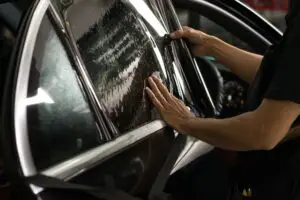Everyone loves a good tint on their car, right? It makes it look sleek and aesthetically pleasing, but it’s also a means of high privacy for many vehicle owners.
Window tint laws were introduced in Oregon in 2003, but the rules enforced in this state regarding tinted windows are different; hence it’s better to double-check the legal guidelines.
Oregon window tint laws allow 35 VLT or more to strictly pass through all the car’s windows.
35% of tint allows both privacy, and if you look closely, you can easily see inside the car. It creates a smooth and stylish look while following the Oregon window tint guidelines.
To find out further about this topic, keep reading below as I dive deeper into the rules and regulations set by Oregon authorities regarding window tinting.
Table of Contents
- 1 How Much Tint Darkness Is Legal In Oregon?
- 2 Window Tint Reflection And Tint Colors
- 3 Medical Exemption Of Window Tint Law In Oregon
- 4 Get A Certified Sticker From The Company
- 5 Other Window Tint Laws Rules And Regulations In Oregon
- 6 Cost Of Car Window Tint In Oregon
- 7 Frequently Asked Questions
- 8 Conclusion
How Much Tint Darkness Is Legal In Oregon?

As I previously mentioned above, there should be a certain light passing through the vehicle’s windows so that the police officers can easily glance inside.
35% VLT is required for vehicles in Oregon, which means 35 VLT or more is to be passed through each window on your passenger car.
Tint Darkness Limit For SUVs And Vans
SUV and van owners get their vehicle tinted no matter what. Usually, owning a family-size vehicle, people prioritize window tinting for privacy.
Non-reflective tint meaning those tints that doesn’t deflect light rays, are allowed on the top 6 inches of the front windshield with a 35% VLT.
The front side windows should also allow a maximum of 35 VLT to easily pass through each side window. A tint darker than that is illegal.
Any level of window tinting darkness can be used for the rear and back side windows.
SUV and van owners usually have full authority over these two windows regarding dark window tinting.
Tint Darkness Limit For Sedans
Now, these rules and regulations are a bit altered when it comes to sedan owners, although tinting is still very much allowed but with a few guidelines such as:
1. Front Windshield
The front windshield of the sedan must have a cogitative tint, and only on the first 6 inches of the front windshield. The rest should be totally clear.
2. Front Seat Side Windows
The front-seat side windows should allow 35 VLT to visibly pass through, and with a glance, the officer should be able to identify you.
3. Rear Window
The sedan’s rear window is also bound to have 35% light in. Usually, this is not a problem with SUVs and vans, but a must need for sedans.
4. Back Seat Side Windows
The back seat side windows should also allow a minimum of 35% light rays to pass in and out of the vehicle.
Window Tint Reflection And Tint Colors
- The window tint reflection laws in Oregon clearly state that if you tint the vehicle’s front windshield, you must only tint the first 6 inches at the top while allowing 35% light in.
- Pensive window tints are also mentioned in the legal guidelines. Using reflective ones is not allowed under any circumstances.
- And in terms of tint color, red, amber, gold, yellow and black are not allowed. Any reflective, metallic or non-visible tint is illegal.
Medical Exemption Of Window Tint Law In Oregon

Medical exemption of window tint law means that you have a serious medical condition and wish to darkly tint your cars, surpassing Oregon’s laws.
In such a case, the higher authorities of Oregon allow darker tinting with a few guidelines.
Legal hardcopy medical report from a licensed physician or optometrist, a prescription, or a letter must be on you at all times and the vehicle and presented to police officers if asked.
If you have been medically exempted for darker window tinting but carry no proof of it, you will be fined with illegal use of the Oregon guidelines in terms of window tinting.
To issue this medical exemption certificate, you will need to consult a doctor within the state and pay a fee for it to be issued with a proper license.
With medical exemption you can get 70% light visibility on the front shield with 20% VLT on all the other windows with 35% light in.
A properly written and certified medical document issued by the Oregon guideline authorities in window tinting is required.
Get A Certified Sticker From The Company
The law enforcement team of Oregon will provide you with a certified sticker when you apply for medical exemption from your window tinting laws due to your medical condition.
This is one of the stickers you will require to place on your car along with.
A certified sticker provided by the shop or company that installs the film or tint on your vehicle the sticker provided will be proof that the tint passes the rules and regulations set by Oregon for window tinting.
And in case you don’t place these certified stickers on your car windows, you won’t be fined as placing the stickers on the vehicle is not issued legally by the law, but I’d suggest having them in your car at all times.
Other Window Tint Laws Rules And Regulations In Oregon
Let’s move on to other window tint laws, rules, and regulations set by Oregon that you also need to be aware of to enhance your knowledge in the subject.
- Dual side mirrors are required if you choose to tint the windows behind the driver.
- The state is very easygoing in placing certified stickers on your vehicle to prove its legal tinting formality; you won’t need to go through that hassle.
- Oregon is also very cooperative with its residents if they have a medical condition and must be medically exempted from putting on lighter tinting shields.
Knowing every aspect of the subject is very important in legal and illegality. Laws in Oregon are always altered from time to time; hence keeping yourself updated is important.
Cost Of Car Window Tint In Oregon
The cost of car window tinting in Oregon is just like any other state. $150 to $400 per vehicle is required $150 if you use affordable film and $400 if you opt for the expensive kind.
Moreover, the cheaper option is doing it yourself, where you buy the tint and apply it yourself.
This will cost you around $100 as you will be saving the fee of paying someone else to do it for you.
These are just rough estimates, though. The actual cost depends on the warranty, the number of windows you tint, the type of tint you use, etc.
Frequently Asked Questions
Q1. Is 15% Tint Legal In Oregon?
No, 15% tint is not legal in Oregon. The only windows the owner can legally tint on their own are the rear and back side windows of a van or SUV.
Q2. Are 5% Tints Legal In Oregon?
No, 5% tints are also illegal in Oregon. Again you can freely tint the back and rear window, but 5 VLT is too dark to be legally allowed in Oregon.
Q3. Is Limo Tint Legal In Oregon?
35% of VLT should pass through the tint, which makes the Limo tint illegal in Oregon.
Its main purpose is to be 95% invisible in terms of light visibility inside the vehicle. People usually use limo tints for 100% privacy.
Q4. Can I Get Pulled Over For Tint In Oregon?
Yes, getting pulled over for tint is feasible in almost every state, not just Oregon. If the officer feels you are not properly following the rules and regulations, you will get pulled over.
Q5. How Much Is A Tint Ticket In Oregon?
A tint ticket is $360 in the state of Oregon. Hence properly follow the guidelines to avoid paying a hefty fee like that.
Conclusion
Finally, with my last statement, I will conclude this article. Tinting laws have changed the game for privacy and illegal actions in any state.
Oregon has properly set up rules and regulations for every citizen to follow to avoid unnecessary occurrences.
Oregon tint laws state everything, what to do and what not to. In case of any medical condition, the state has properly lined out rules for a citizen to follow.

I am Tahir Azam, and I have been writing amazing articles for TaxiHack for as long as I can remember. I know everything that is to know when it comes to automobiles and is always on top of industry news and developments. While I am not an expert by any means, I pride myself on knowing the ins and outs of many different problems and, of course, their solutions. The articles on our website are some of the best and well-researched content that you will find, and I spend countless hours making sure this remains to be true. This is why I ask you to take your time out and read some of my articles, especially if you find a topic that resonates with you or is something you are looking into. This way, you will find the perfect mix of information and tips on your desired topic. Learn more about Tahir.



